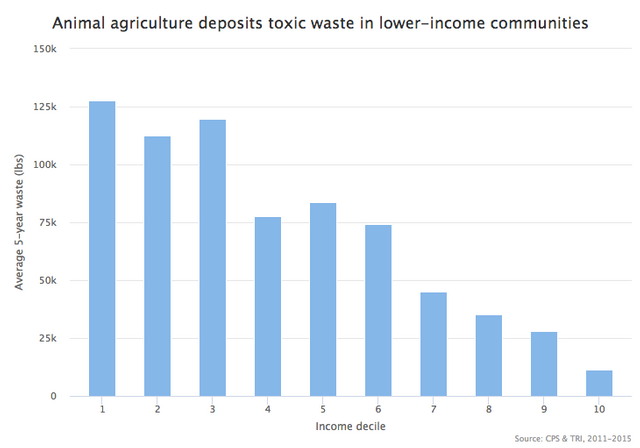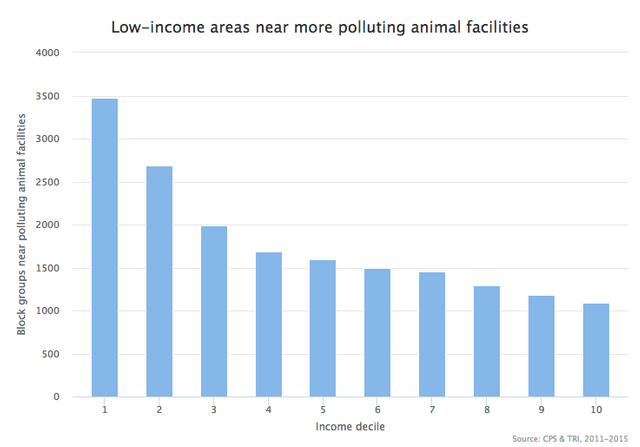Animal Agriculture Waste Mirrors Income Inequality
The current level of waste created by industrial animal agriculture is untenable.
Animal agriculture in the United States is increasingly industrial, as shown by the dramatic inflation of waste created by the industry. This trend has wrought consequences for animals, workers, public health, and climate change. I recently examined data from the Current Population Survey and the Toxics Release Inventory to show that low-income communities bear the burden of waste and pollution produced by industrial animal agriculture, to the detriment of community health and quality of life. This post revisits these data.

The graph above shows the average amount of animal waste released over a 5-year period near communities of each income decile. Communities here refer to census block groups, which are "generally defined to contain between 600 and 3,000 people." There are 219,124 block groups in this analysis. Income decile is determined by calculating each block group's income per person. The amount of waste proximal to each block group was calculated using the method described previously.
The very clear trend is that, on average, low-income communities are closer to more animal agriculture pollution than high-income ones (F(1, 219124) = 130.6, p-value: < 2.2e-16). This relationship is partly driven by the dramatic likelihood of waste-producing animal agriculture facilities to exist near low-income areas:

The impact of animal waste in low-income areas can be devastating for a community, which is especially well documented in Duplin, NC and its neighboring hog industry. Adults living near industrial animal agriculture experience higher rates of increased blood pressure and poor respiratory health, while children experience higher rates of asthma. In addition, livestock workers have unusually high mortality rates for hypersensitivity pneumonitis, tuberculosis, asthma, and influenza.
These health impacts may be especially dramatic because the affected communities are more likely to depend on well water, which can be impacted by seeping manure lagoons that are regularly used to manage waste. Water supplies can also be impacted when these lagoons leak, or are hit by a hurricane, which has happened 3 times since 1996 and caused billions in damages.
The social untenability of industrial animal agriculture calls for not only the boycott of its products, but structural change in the United States agriculture system that gives way to human abuse and exacerbates inequality.
All code used to process data and create graphs is on GitHub. Content cross-posted on my personal website.

This is really incredible research @somethingburger. One minor suggestion - for Steemit - it might help to add a paragraph at the beginning or end to summarize the scope of your study. Almost like an abstract to help guide people into your work. Each article is extremely professional and well documented... so much so that passerby's might think you lifted this stuff from a scientific journal!
A comment more related to your work - at first it might seem obvious that lower income neighborhoods congregate around agricultural waste areas. Simply because smelly land makes for cheap real estate makes for cheap housing. But, what raised my eyebrow were your comments about well water contamination / asthma / natural disasters.
That's something that legislation could really address and perhaps mitigate. Have there been any kind of environmental protection precedents (or zoning laws) set in other states that North Carolina could draw from?
Congratulations @somethingburger! You have completed the following achievement on Steemit and have been rewarded with new badge(s) :
Click on the badge to view your Board of Honor.
If you no longer want to receive notifications, reply to this comment with the word
STOPTo support your work, I also upvoted your post!
This post mistakenly measured waste produced by slaughterhouses and meat processing facilities rather than the livestock farms themselves. Here is an updated version of this post and code that measures livestock waste as intended, and contains additional analysis.